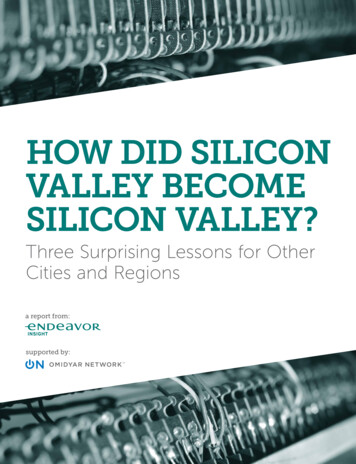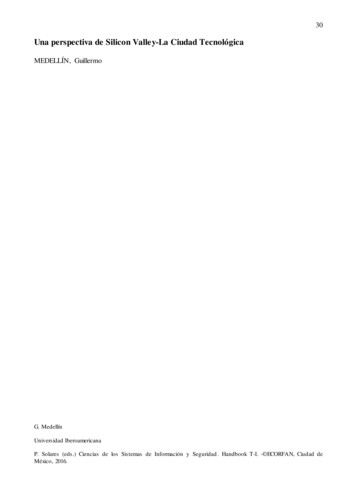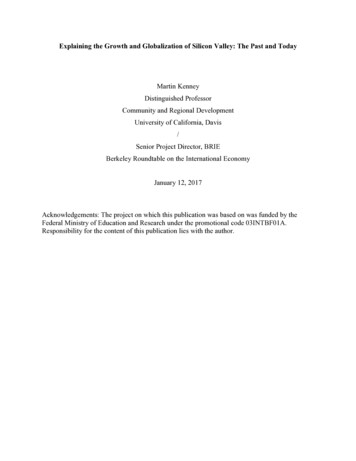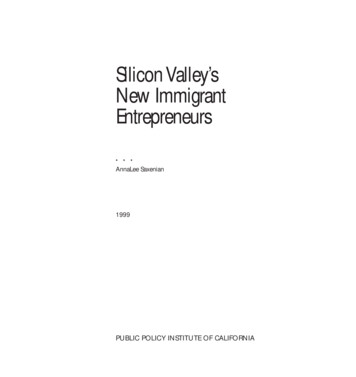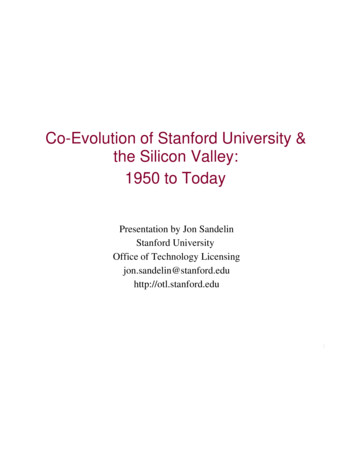Transcription
Serving Silicon ValleyTech Giants and their Service Workersin the COVID-19 PandemicWORKINGPARTNERSHIPSUSASERVING SILICON VALLEYNOVEMBER 20201
Serving Silicon ValleyTech Giants and their Service Workersin the COVID-19 PandemicNovember 2020KEY FINDINGS Roughly 14,000 unionized tech cafeteria workers, janitors, andsecurity officers work in Silicon Valley.* An estimated 63% of workers in those blue-collar tech occupationsare Black or Latinx. Nearly 1 out of 8 Latino men in Silicon Valley (12.1%) works in ajanitorial, security, or foodservice occupation. People working in unionized tech cafeteria, janitorial, and securityjobs earn an estimated 538 million per year, incomeessential to supporting their families and to maintaining localeconomic activity.* Throughout this brief, “Silicon Valley” is defined for data analysis purposes as Santa Clara and San MateoCounties.SERVING SILICON VALLEY2
CONTENTSIntroduction.4Most blue-collar tech workers are Black or Latinx. Keeping those jobs has been alifeline for communities of color.6The direct economic impact of Silicon Valley’s unionized blue-collar tech workers isroughly 538 million annually.8An estimated 12,000 workers have access to health coverage through unionized bluecollar tech jobs, helping to equalize racial health disparities.9In Silicon Valley, an estimated 6,500 families with children depend on unionized bluecollar tech jobs.11Silicon Valley’s tech companies have received billions in public subsidies and taxincentives, including at least 654 million in federal COVID-19 relief funds.12What happens if tech companies lay off their blue-collar service workers?.14SERVING SILICON VALLEY3
IntroductionAs the spread of COVID-19 has forced layoffs and businesses closures inmany sectors, Silicon Valley’s software engineers, programmers, andother white-collar tech employees have largely been spared.In Santa Clara County, nearly 100,000 jobs have been lost and not yetreturned. Industries like restaurants and hotels have cut jobs by nearly40%. Yet in the Computer Systems industry, not only were layoffsavoided, employment is actually up, with 1,800 jobs added in July andAugust.1By investing in technology and human resource systems to enableremote work, the Silicon Valley tech industry has largely been able tokeep its white-collar workforce employed throughout the pandemic. Butwhat about its blue-collar, largely subcontracted workforce?As our previous studies have shown, the Silicon Valley tech industry ishighly segregated by occupation, with Black and Latinx workers hugelyover-represented in blue-collar tech service jobs and severely underrepresented in the higher-paying, white-collar tech jobs.2Recognizing the potential devastating impacts of this disparity, as wellas the need to maintain a stable local workforce for their campuses,many leading tech companies have continued to employ and pay theirsubcontracted workers, even as their offices and campuses have beentemporarily closed or are open for only restricted uses.As a result, more working families in the Silicon Valley region have beenable to maintain their income and health coverage, cushioning someof the disparate economic impacts of COVID-19 which in general havefallen most heavily on communities of color, women, and immigrants.As of September 2020, the unemployment rate in the greater San Joséregion was 7.1%. While high relative to normal times, this was the lowestrate of any metro region in California.3This brief focuses on three of the largest blue-collar tech service jobs:tech cafeteria workers, janitors, and security officers. It examines theeconomic benefits of retaining those workers during the pandemicand the likely effects on the broader community. Finally, it attempts toproject some of the potential impacts if tech companies were to reversetheir decision and lay off these blue-collar workers.SERVING SILICON VALLEY4
At the start of the pandemic, everything wasscary and stressful. COVID-19 hit our familyhard and we lost a beloved family member. Wewere so heartbroken and scared about how tostay safe in the middle of the pandemic. It wasstressful because we have seen people lose theirjobs. We kept saying “we will be ok,” but wewere also asking “are we going to be ok?”Madeleine & Francisco’s StoryWe are Madeleine and Francisco. We haveworked at Google since 2014. Working at Googleis our story as employees and as a family.I, Madeleine, started as a barista and had theopportunity to learn all the jobs in the front ofhouse so that today I’m a café supervisor. I lovetalking to Googlers and getting to know them.Connecting with my coworkers makes Googlea fun place to be where we get to try new foodsand learn new culinary secrets.I, Francisco, love that I have had the opportunityto learn all aspects of working in the kitchen.From starting out as a dishwasher, I’vemoved up and now I’m training to be a linecook. It is a privilege to cook every day, learnnew techniques, different cuisines, and newingredients to cook with. I enjoy seeing howenthusiastic people are to eat our food and howproviding good food makes people happy.We met each other working together in the café.We fell in love and married in 2018. Now we havea son, August. We are grateful that Google is aplace where we can establish our careers for thelong run and build a future for our family.SERVING SILICON VALLEYGoogle has a lot of employees to support,but we have felt reassured since Google hascommitted to continue our pay and benefits. Butit’s nerve racking not knowing how long this willgo on.If Google had not decided to support us, wewould have to find the next job available,something quick, and accept the workingconditions, even if it wasn’t safe. If we chose notto risk exposing our family, we could have beenunemployed. This would have been devastatingbecause our family’s future depends on both ofus being able to work and to care for the family.Google making the commitment to supportus, their café workers, has been a blessing. Wehave been able to stay safe at home, continue topay our bills, and spend valuable time with ouryoung son. With the health benefits, we havebeen able to stay healthy, get our flu shots, getthe medication we need and go to the doctoron regular basis, especially important with oursmall child.As we think of our future, there are manyeconomic uncertainties. At the same time,we are so grateful to be part of building a safeworkplace where we have job security, goodbenefits, and a career ladder. Being part ofthe Google community gives us confidence tocontinue to plan for our future.5
Most blue-collar tech workers areBlack or Latinx. Keeping those jobs hasbeen a lifeline for communities of color.Despite diversity initiatives, the tech industry continues to becharacterized by extreme occupational segregation. Among softwaredevelopers — the largest white-collar tech occupation in Silicon Valley— just 4% are Black or Latinx.4,5 In contrast, among the major blue-collartech service occupations, the majority of workers are Black or Latinx.As shown below, 46% of building security officers, 70% of cafeteriaworkers, and 71% of janitors in Silicon Valley are Black or Latinx.6 Thiselevates the importance of tech companies retaining these jobs: layingoff their majority Black and Latinx workforce while retaining their whitecollar workforce would greatly exacerbate racial disparities.Latino men are particularly concentrated in these jobs. Among allLatino men in the workforce in Silicon Valley, 12.1% — nearly one ineight — works in the janitorial, security, or foodservice occupations. Thatmakes the blue-collar tech occupations critical for Latinx families andcommunities.Black/Latinx tech workersSHARE OF TECH-LINKED WORKERS IN SILICON VALLEYWHO ARE BLACK OR LATINX70%71%46%4%Security OfficersCafeteria WorkersLatinxJanitorsSoftware DevelopersBlackSource: US Census Bureau, American Community Survey (ACS) 5-Year Estimates – Public Use Microdata Sample 2018.SERVING SILICON VALLEY6
Gregory’s StoryMy name is Gregory. I was born and raised inEast Palo Alto and still live here. I have alwaysbeen interested in working in the food industryand two years ago, I saw the opportunity atFacebook. I applied and got hired first intothe Butcher Block Café. Now I’m working atFacebook in the Duo Café.Working at Facebook and being in the uniongives me the security and the income I needto maintain a decent living in the Bay Area. Itallows me to help my mom with rent, coverexpenses around the house, and taking care ofmy bills. But most of all, I love my job and enjoybeing at work.Since the pandemic, I’ve spent most of my timegiving my mom a hand with her chores andhelping our neighbor with yard work, runningerrands, and any other assistance they mayneed.I am eager and looking forward to go back towork. I miss my co-workers, I miss being in apositive and supportive environment and I missgoing to work and coming home from work.Until we can go back to work, I am gratefulthat Facebook continues the paid leave. It alsomeans my health insurance continues andthat is very important, especially during thispandemic.SERVING SILICON VALLEY7
The direct economic impact of SiliconValley’s unionized blue-collar techworkers is roughly 538 million annually.Data note: For the following sections, data are presented on union janitors,security officers, and tech cafeteria workers, using local union data on wagesand health insurance. Equivalent data for non-union workers on tech campuseswas not available. These therefore represent a low-end estimate of theeconomic and community impacts.Based on the number and wage ranges of unionized janitors, security officers,and tech cafeteria workers in Silicon Valley, the direct economic impact ofthese jobs, measured in estimated total wage income, is approximately 538million per year.7 (This does not include health benefits, which are discussedin the next section.)This 538 million in income supports the workers and their families andcirculates in the local economy, further supporting local businesses andworkers. Using local industry economic multipliers to estimate the economicimpacts of that circulation, the employment of unionized janitors, securityofficers, and tech cafeteria workers in Silicon Valley increases total earningsfor workers throughout the region by an estimated 718 million. This includesnot only direct earnings, but also the multiplier effect when workers spendthose earnings, which helps create more jobs.8Braulia’s StoryMy name is Braulia, and I ama commercial janitor. I amlucky to work at Google duringthe pandemic, where we arerecognized as essential workers.We received hazard pay in themiddle of the pandemic. It wasvery helpful in getting my familythrough tough times.SERVING SILICON VALLEYAnd thank God that when someof our colleagues were exposedto the virus, Google and ABM paidfor their two weeks of quarantine.It is a pleasure to thank Googlefor their recognition of ouressential work and I hope thatother companies and buildingowners follow their goodexample.8
An estimated 12,000 workers haveaccess to health coverage throughunionized blue-collar tech jobs, helpingto equalize racial health disparities.Now more than ever, affordable, accessible healthcare is critical to thewell-being of our communities. But our healthcare system suffers from hugeracial disparities. Overall, Black and Latinx residents of Silicon Valley arenearly 30 percentage points less likely than white residents to have jobbased health coverage. Pre-pandemic, 71% of white Silicon Valley residentswere covered by job-based health insurance, compared to just 43% of Blackand Latinx residents.9Unionized blue-collar tech jobs are one avenue where Black and Latinxworkers are able to access affordable, high-quality health coverage.Among unionized tech cafeteria workers, an estimated 93% have employerprovided health insurance.10 For janitors and security officers, wherea local occupation-specific estimate was not available, we applied theestimate produced by the U.S. Bureau of Labor Statistics’ 2020 NationalCompensation Survey for union members offered health insurance, whichis a take-up rate of 81%. As a rough estimate, that means around 12,000service workers have access to employer-provided health coverage throughthese jobs.Health coverage by raceSHARE OF POPULATION WITH JOB-BASED HEALTHINSURANCE71%55%43%Black or LatinxAsian & Pacific IslanderWhiteSource: US Census Bureau, American Community Survey (ACS) 5-Year Estimates – Public Use MicrodataSample 2018.SERVING SILICON VALLEY9
I have been really impressed by the way thatGoogle has reacted to COVID-19 by committingto continue our salaries and benefits. I amcommitted to do my part and get through thistogether. If it wasn’t for Google’s compassionfor us we would not be able to survive thispandemic.Idalia’s StoryMy name is Idalia . I have worked at Google for7½ years. I started off as a dishwasher andworked my way up to a lead cook. I live in SanJose with my three kids and one more on theway. I have worked hard at Google to learn,grow, and provide stability for my family.Like many people, when this pandemic startedI was really scared: scared getting sick couldaffect my pregnancy, scared I could lose myjob and health insurance, and scared that myhusband and I would be unable to pay to keepthe roof over our head.When the pandemic began I had just found outI was pregnant and my oldest daughter wasabout to begin her first year at DeAnza college.My daughter tells me that she wants to use herstudies to help other people. As a mother thatmakes me extremely proud.SERVING SILICON VALLEYThere is something special about beingincluded in the Google community. I knowthat I can tell anyone that it is a good placeto work. When people ask me how I see myfuture, I can picture myself retiring at Google.Our workplaces are constantly innovating andcreating new programs and I like that they arenot stuck in the same thing. It is a great feelingseeing how they respect the hard work mycoworkers and I put in to making Google a greatplace to work.Before working at Google, my daughter neededsurgery but we were in hard times and she didnot have insurance. We had to wait for approvalthrough assistance programs to go through withthe surgery and it took eight months for her toget the care she needed. The security Googlehas provided us means I know that we willcontinue to have the excellent union healthcarewe need, during my pregnancy, and during thisglobal pandemic.Because of the pandemic and the changingenvironment, we have all had to learn newthings and grow, from virtual learning, to newsafety protocols. But I know that if we sticktogether as a community we can get throughthis.10
In Silicon Valley, an estimated 6,500families with children depend onunionized blue-collar tech jobs.Many janitors, security officers, foodservice and other service workerson Silicon Valley’s tech campuses have built a career there, workingtheir way up through training and experience, in order to support theirfamilies and provide a better future for their children.An estimated 6,500 families in Silicon Valley support their children byworking at a unionized janitorial, security, or tech cafeteria job. (Familieswith two or more members working at these jobs are counted onlyonce.)Alma’s StoryMy name is Alma. I am a single mom supporting mytwo daughters through their education, as well as mymother who completely depends on me. I’ve beenworking at Verizon as a barista for six years.I love my job because I get to interact with differentpeople while moving my family forward andproviding good health insurance for my daughters.Verizon’s decision to cut our salary and medicalbenefits means that I may no longer be able to paythe rent, let alone be able to help my mother andmy daughters. My daughters depend on my healthinsurance from my work with Verizon. I’m very afraidof getting sick or my daughters getting sick and notbeing able to pay.I don’t know what to do, because there aren’t manyjobs and if I got infected with the virus while working,I won’t have health insurance.SERVING SILICON VALLEY11
Silicon Valley’s tech companies havereceived billions in public subsidiesand tax incentives, including at least 654 million in federal COVID-19 relieffunds.The tech industry has benefitted enormously from public resourcesand infrastructure, starting with its very beginnings built on taxpayerfunded research and development. Throughout their development,tech companies have continued to benefit immensely from publiclyfunded support, subsides, contracts, preferential treatment in tradenegotiations, and tax advantages.In just one example, the new U.S. tax law passed in 2017 provided anestimated 2018 tax benefit of 5.558 billion to Apple, 4.048 billionto Alphabet (Google’s parent company), 4 billion to Verizon (Yahoo’sparent company), and similar windfalls for other tech and biotech megacorporations.11Most recently, many tech companies have sought and received federalfunding from COVID-19 relief programs, either as loans (often forgivable)or as contracts. Using the database of federal CARES Act COVID-19 relieffunding at data.covidstimuluswatch.org, we examined dollars awardedto tech companies that employ unionized cafeteria workers on theirSilicon Valley campuses.Those selected Silicon Valley tech companies receive a total of 653,891,490 in federal CARES Act COVID-19 relief funding: 397,282,329in loans and 256,609,161 in contracts.12SERVING SILICON VALLEY12
I love working at nVidia because I love to cookand interact with all the clients. After 20 years,I know everyone who comes into the café,including the owner of the company, Jensen. Ihave personally had the opportunity to cookfor Jensen and seen how he loves the workersas his family. Even though we aren’t directemployees of nVidia, we are motivated to putour heart and soul into our efforts.When COVID-19 swept through the community,nVidia continued to support us. With the pay, Ihave been able to keep a roof over my family.With our health insurance protected, I havemade sure we can stay healthy.One of my sons has asthma and my other songot sick and was hospitalized a few months ago.Without our pay and health benefits protected,my family would be in a serious crisis situation.Marcial’s StoryMy name is Marcial. I have lived in Santa ClaraCounty for 23 years. I am a single father of threeboys: Jose Manuel age 16, Fernando age 11, andJavier Alonzo age 7.When I moved here from Jalisco, I had dreamsof building a future, having a car, a house,making something of my life. I started workingin the café at nVidia back in 2001 as a grillcook. After three years I was promoted to leadcook. Working at nVidia has been a wonderfulexperience where we are protected andappreciated.SERVING SILICON VALLEYThrough this pandemic, I have been shelteringin place as we all have to make sure we stayhealthy. I have dedicated my time to my family.It has been difficult for my kids to be in thehouse all day and to not be able to be in schoolwith their friends. But it has been an advantageto spend time together and to mutually supporteach other how we can get through this crisis.I am so grateful that we cafeteria workers aresupported and protected as part of the nVidiafamily.13
What happens if tech companies layoff their blue-collar service workers?To date, most major tech companies in Silicon Valley have retainedtheir service workers, especially those where the service workers haveorganized a union. However, with many predicting no return to officesuntil mid-2021, a few companies have broken ranks and begun to lay offtheir blue-collar service workers.For example, in September, 120 cafeteria workers at the Verizon/Yahoocampus in Sunnyvale were laid off. Said Augustina Sanchez, one of thelaid-off workers, “I have worked in the cafeteria at this tech campusfor 12 years and I am so disappointed for me and my coworkers thatVerizon is not doing the right thing. I am a single mom to my son who isa university student. I support us and unemployment will not be enoughto pay my rent and bills. Now I am trying to find another job whileeverything is closed. I am trying to remain strong for my family and formy coworkers.”If — hypothetically — all tech companies were to lay off their blue-collarservice workers, the impacts to Silicon Valley’s communities would bewidely felt.If all of Silicon Valley’ unionized janitors, security officers, and techcafeteria workers were to be laid off, projected impacts include: Total unemployment in the region could increase by more than 10%,from 103,400 unemployed workers (all industries) to roughly 117,400unemployed. Up to 12,000 service workers could lose health insurance coverage,along with family members who depend on that coverage.13 An estimated 6,500 families with children would lose a major sourceof income.14 An estimated 8,300 renters could be at risk of being unable to payrent.15 538 million in wages would be pulled out of workers’ pockets, andout of the communities where they live and shop, resulting in anestimated 718 million in negative impact to earnings in the regionoverall.16SERVING SILICON VALLEY14
Over the past five years, nearly 9,000 subcontracted tech serviceworkers in Silicon Valley have joined together in unions, winninghigher wages, healthcare benefits, and a collective voice in their jobs.This collective movement has helped make Silicon Valley survivablefor thousands of Black and Brown families and communities whoselabor makes tech run.If tech companies make the decision to permanently lay off thoseworkers — perhaps replacing them with new, lower-paid contractorswhen campuses eventually re-open — the region may see longterm, even permanent increases in racial income disparities,housing access, and potentially acceleration of the already severedisplacement crisis.Gina’s StoryMy name is Gina, and I’m a janitor at Genentech. I am the breadwinner for my own family aswell as the primary support for my loved ones in need back in Nicaragua. I send money hometo my mother for her healthcare needs, which have worsened ever since she tested positive forCOVID-19.I had been working at Genentech for a year and a half when I received the news that I would beamong those laid off in September. Since then I have been struggling. Unemployment checks arelate to arrive since the EDD is so backed up, and meager in amount when they finally do reachme.I am trying to help others who are also struggling. My coworkers are constantly reaching out tome in search of support. I’m a union steward at Genentech, a role that my coworkers nominatedme for within my first year.Excessive workloads, abusive treatment from supervisors, and general anti-union sentimentfrom our bosses have been issues at my workplace for as long as I’ve been there. Now ouremployer is trying to squeeze more work out of less people. My union siblings that were not laidoff are bearing the brunt of that squeeze.SERVING SILICON VALLEY15
ENDNOTES1California Employment Development Department, Current Employment Statistics (CES). e-bw2e2See e.g., “Tech’s Invisible Workforce”, Working Partnerships USA, March 2016. kforce/3California Employment Development Department, California Labor Market Review – September 2020,published Oct. 16, 2020. Market-Analysis/calmr.pdf p.10,”Unemployment Rates for Largest Areas.”4Throughout this report, all data specific to “Silicon Valley” include Santa Clara and San Mateo Counties, unlessotherwise specified.5U.S. Census Bureau, American Community Survey (ACS) 5-Year Estimates - Public Use Microdata Sample 2018.6Ibid.7Working Partnerships USA analysis of union membership and typical wage data provided by UNITE HERELocal 19 and SEIU-USWW. Analysis assumes full-time employment. Note that this number may also includebuilding services at other large office campuses, since data is not available to cleanly differentiate servicesat tech versus other types of office /R&D campuses. However, in Silicon Valley, the large majority of majoroffice/R&D campuses are occupied by tech or biotech companies.8Analysis by Working Partnerships USA using RIMS II Multipliers produced by the Bureau of Economic Analysis.Multipliers used are the Type II Direct Effect Earnings multipliers for the industries 5616 (Investigation andsecurity services), 5617 (Services to buildings and dwellings), and 722A (All other food and drinking places) inSanta Clara & San Mateo Counties.92018 California Health Interview Survey, UCLA. https://ask.chis.ucla.edu/10Working Partnerships USA analysis of health insurance data provided by UNITE HERE Local 19.11Americans for Tax Fairness, te-tax-cuts/ . Includes thosecorporations that have either reported their estimated 2018 tax cut or for whom independent analysts haveprovided an estimate for the 2018 impacts of the Tax Cuts and Jobs Act (TCJA) of 2017.12COVID Stimulus Watch, Good Jobs First, https://covidstimuluswatch.org/13Working Partnerships USA analysis of union membership and health insurance data provided by UNITE HERELocal 19 and SEIU-USWW.14U.S. Census Bureau, American Community Survey (ACS) 5-Year Estimates - Public Use Microdata Sample 2018.Number of union workers estimated using data provided by UNITE HERE Local 19 and SEIU-USWW.15Ibid.16Analysis by Working Partnerships USA using RIMS II Multipliers produced by the Bureau of Economic Analysis,supra.SERVING SILICON VALLEY16
WORKINGPARTNERSHIPSUSAWorking Partnerships USA is a communityorganization bringing together the powerof grassroots organizing and public policyinnovation to drive the movement for a justeconomy.wpusa.orgSilicon Valley Rising is a coordinatedcampaign driven by a powerful coalitionof labor, faith leaders, community basedorganizations and workers that’s inspiringthe tech industry to build an inclusivemiddle class in Silicon Valley.siliconvalleyrising.orgIAM 93SERVING SILICON VALLEY17
SERVING SILICON VALLEY 2 KEY FINDINGS Roughly 14,000 unionized tech cafeteria workers, janitors, and security officers work in Silicon Valley.* An estimated 63% of workers in those blue-collar tech occupations are Black or Latinx. Nearly 1 out of 8 Latino men in Silicon Valley (12.1%) works in a janitorial, security, or foodservice occupation.
